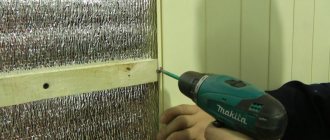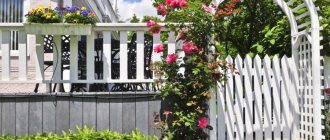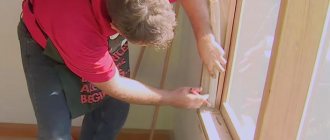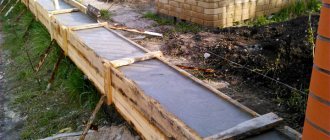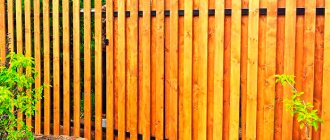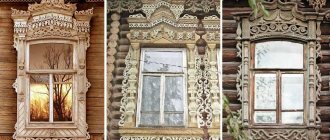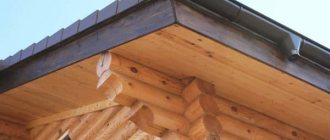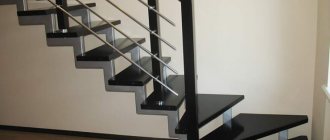- Properties and advantages of metal fence sheets
- Dimensions of corrugated sheets for fences
- Profiled sheets for fences: price per sheet
- Corrugated fences: design of modern fences
- Types of fence structures made of corrugated sheets
- How to make a fence from corrugated sheets: step-by-step instructions
- DIY methods for installing fence posts
- Installation of horizontal guides and fastening of corrugated sheets
- Attaching the corrugated sheet to the frame
- Features of installing a fence on an uneven area
- Mistakes when installing a corrugated fence
- Features of caring for a fence made of corrugated sheets
- Video: DIY corrugated fence installation
Fencing your territory has always been and will be an integral part of the arrangement of a private home. The desire to hide your home from prying eyes and uninvited guests is inherent in any person. And in the modern world there is a desire to create a decorative decoration for the landscape. For this purpose, a fence is installed. When erecting such a structure, everyone is guided by their own preferences when choosing height, material, manufacturing method and design. Our article will tell you how to install a corrugated fence with your own hands. Having studied the methodology for constructing this fence and analyzed the existing nuances and secrets of installation, even a novice builder will be able to do such work.
Fence blinds: how to make it yourself (read more)
Corrugated sheeting withstands temperature changes and moisture.
Properties and advantages of metal fence sheets
Comfort, reliability and practicality. This is exactly how this material can be characterized. A variety of color solutions allows you to choose a material that matches the existing cladding and roofing coverings. And the light weight and simple installation method makes it possible to install a fence from corrugated sheets with your own hands, even with minor construction skills.
The popularity of corrugated fences is growing every day. The times when builders used it only to cover the roofs of non-residential buildings, garages and for fencing construction sites are gone. Today, corrugated sheeting, which is based on a galvanized metal sheet, is considered a universal material for constructing a fence. It is successfully used for fencing areas for private, public and industrial use.
The structural strength of the material is given by its shape in the form of a corrugated profile.
The material has a number of unique properties that make it possible to give preference to the installation of fences made of corrugated sheets:
- high strength and durability - thanks to the stiffening ribs, the profiled wall sheet has strength and low weight. The strength of the panels is affected by the thickness of the sheet, the shape and height of the stiffeners. The polymer composition of the coating prevents corrosion and provides the material with a long service life, which can be 40-50 years;
- resistance to wind loads - depending on the strength of the prevailing wind in your region, you can select the required thickness of the sheet that can withstand such a load;
- wide range of colors - corrugated sheets are available in various colors, which can be selected according to the RAL scale (color standard), focusing on individual preferences and maintaining the architectural composition;
- versatility - the material can be used not only for fencing, but also for the construction of small outbuildings and sheds;
- sufficient noise insulation - the fence can block street noise and the hum of passing cars;
- simplicity and ease of installation - corrugated sheeting is a lightweight material, even one person can install it, fastening is carried out using special self-tapping screws with a polymer coating;
- easy to maintain - the profiled sheet is easy to clean in the usual way and does not require periodic repairs. If accidental damage occurs during the installation process, it can be quickly eliminated by treating the scratches with paint of the appropriate color from a can;
- attractive price - metal profile sheets for fences have an acceptable cost in comparison with materials such as traditional metal, brick or stone.
On a note! When choosing corrugated sheets for fencing, give preference to wall sheets that are lighter in weight and have a variety of profile shapes. This material has a lower cost than its roofing counterpart and, as a fencing, can easily cope with wind loads.
Profiled sheets are distinguished by the height and pitch of the ribs, which affects the strength of the material.
Wall corrugated sheeting used for fences is characterized by a profile shape with a small trapezoidal height - 8-25 mm and is distinguished by the simplicity and elegance of the coating. It can be used as an independent enclosing structure and as a background, for example, for a wrought iron fence.
Features of metal profiles as a material
A metal profile is a profiled metal sheet (corrugated sheet, corrugated sheet, corrugated sheet) made of galvanized steel. In the process of producing corrugated sheets, the so-called cold rolling method is used - the metal sheet passes through a special rolling mill with rollers. The result is a profiled sheet of metal with a wavy or trapezoidal profile shape, which affects not only the aesthetic appearance of the material, but determines its rigidity.
Profiled sheets marked C8 are used for cladding fences and fences
After cold rolling, a protective polymer or paint coating is applied to the profiled sheet according to the RAL color standard. The polymer layer protects the metal from corrosion processes. A wide selection of color solutions allows the use of corrugated sheets in the construction of not only industrial facilities, but also for cladding residential buildings.
The main area of application of profiled sheets is the cladding of walls and roofs of industrial and residential buildings, the construction of enclosing and protective structures. Thanks to the steel base and profiled stiffening ribs, the material provides high strength, reliability and tightness, without weighing down the load-bearing structure of buildings.
According to the area of application, corrugated sheets are classified into 3 types:
- N - material with a thickness of 0.55 to 0.9 mm, used for cladding roofing structures;
- C - profiled sheet with a thickness of 0.55–0.7 mm, intended for cladding fences, fences, walls and wall partitions;
- NS is a universal profiled sheet with a sheet thickness of 0.55–0.8 mm. Can be used both for cladding roofs and for cladding walls, fencing and fences.
For the construction of fences, it is recommended to use corrugated sheets marked C8, C25, NS20 or NS35. The index after the letter indicates the profile height in mm. Depending on the manufacturer, the length of the sheet can vary from 0.5 to 12 m.
Advantages and disadvantages of corrugated sheets
The competitive advantages of profiled sheets as a material for the construction of fences include:
- Light weight - when using corrugated wall sheets, there is no need to install a massive frame made of thick metal supports or concrete. To cover the fence, no special equipment is required, since feeding and supporting the sheet in weight is carried out by one or two people.
- Easy installation - in the process of attaching the corrugated sheet to the supporting frame, ordinary metal screws with a rubber or silicone washer are used. The tool used is an electric screwdriver with an appropriate bit.
Basic colors of profiled sheets according to the RAL standard
- Availability - the material has a wide selection of sizes and colors. The cost of the material depends on the region and manufacturer, but on average a C8 1200×1800 profiled sheet will cost 500–550 rubles.
- Service life - a profiled sheet of galvanized metal with a polymer protective coating is reliably protected from chemical and physical damage. The average service life of the material is at least 15–20 years.
If the polymer and paint coating is damaged, the metal profile loses its corrosion resistance. This, in fact, is its main drawback, which can be solved by periodically inspecting the front surface of fences and walls for serious damage. To eliminate traces of rust and chips, special paints are used, applied after preliminary surface treatment.
Dimensions of corrugated sheets for fences
In order to correctly calculate the required amount of material when installing a fence from corrugated sheets with your own hands, as well as to correctly plan the step between the support posts, you need to have an idea of its main dimensions and markings.
Corrugated sheets, taking into account the configuration and height of the profile, are classified into separate groups:
- marking C - wall profiled sheet used for the construction of walls, partitions and enclosing structures, as well as for decorative cladding of surfaces and insulation of walls;
- marking N - load-bearing corrugated sheet used for construction or strengthening of load-bearing structures;
- NS marking is a universal metal profile that has found application in roofing, finishing walls and ceilings. It is distinguished by a significant sheet height with a small thickness and wave height.
The main difference between a wall profile and a load-bearing profile is the height of the trapezoid and the presence of additional stiffeners. This difference is explained by the use of grade N corrugated sheets in structures where the loads on the material are much higher.
The length of the sheets varies depending on the manufacturer of the metal profile and ranges from 0.4 to 12 m, but the standard height is 2 m. Below are the parameters of the most used grades of corrugated sheeting.
Profiled sheet for fence: sheet sizes:
| Sheet parameters, mm | Grade of profiled sheet | |||||
| From 8 | From 10 | From 18 | From 20 | From 21 | CH 35 | |
| Overall Width | 1200 | 1150 | 1150 | 1150 | 1051 | 1060 |
| Working width | 1150 | 1100 | 1100 | 1100 | 1000 | 1000 |
| Metal thickness | 0,4:0,8 | 0,4:0,8 | 0,6:0,7 | 0,45:0,7 | 0,4:0,7 | 0,5:0,9 |
| Wave height | 8 | 10 | 18 | 20 | 21 | 35 |
| Distance between ribs | 62,5 | 45 | 91,67 | 137,5 | 65 | 70 |
Fence made of corrugated sheets with metal posts, recommendations for choosing material
So, for fences and barriers the following grades of corrugated sheets are recommended: C8, C10, C20, with a sheet thickness of 0.5 mm
We choose a profiled sheet for a fence: painted profiled sheets are a little more expensive, but their service life is longer.
Since the fence is a vertical structure on a frame, there is no snow load, and only wind is taken into account. It is calculated for each region separately depending on the wind rose.
In the construction market, you can choose simply galvanized or painted metal profile sheets. The latter are a little more expensive (approximately 20%), but, accordingly, they have a longer period of trouble-free operation.
Profiled sheets for fences: price per sheet
The cost of a profiled sheet depends on several factors: metal thickness, profile shape and type of protective polymer coating. As the thickness of the metal increases, its cost increases. For example, the price of corrugated sheeting with a thickness of 0.7 mm will be approximately a third higher than a similar sheet of 0.4 mm.
Galvanized corrugated sheets are considered quite inexpensive. The zinc coating makes the material resistant to corrosion compared to conventional sheets. In turn, corrugated sheeting with a polymer coating has a greater degree of protection, but its price is 30-35% higher than galvanized sheeting.
As for the shape of the profile, the higher it is, the larger the stiffener and the higher the load-bearing capacity of the sheet. Accordingly, the cost of such material will be higher. The number in the metal profile marking indicates the wave height in mm. To build a fence from corrugated sheets with your own hands, they mainly use a wall profile, which is considered the most economical; roofing corrugated sheeting is less often used.
Below are estimated prices for popular types of profiled sheets from different manufacturers.
On a note! In order not to overpay for the brand when purchasing corrugated sheeting, you can purchase the material from less well-known manufacturers who produce high-quality products. You should first read the reviews and recommendations.
Price of metal profile sheets for fence:
| Brand, manufacturer | Brand | Coverage type | Metal thickness, mm | Sheet width, mm | Sheet length, mm | Price per m², rub. | |
| full | working | ||||||
| Grand Line Optima, Russia | C08 | No | 0,4 | 1200 | 1160 | 500-8000 | 209 |
| Grand Line Optima, Russia | C08 | polyester | 0,35 | 1200 | 1160 | 500-8000 | 232 |
| Grand Line Optima, Russia | C08 | polyester | 0,4 | 1200 | 1160 | 500-8000 | 239 |
| Grand Line Optima, Russia | C10 | No | 0,5 | 1180 | 1150 | 500-8000 | 318 |
| Grand Line Optima, Russia | C10 | polyester satin | 0,5 | 1150 | 1110 | 500-8000 | 350 |
| Grand Line Optima, Russia | C08 | polyester | 0,4 | 1200 | 1160 | 2000 | 577 |
| Grand Line Optima, Russia | S21 | polyester | 0,5 | 1051 | 1000 | 500-12000 | 698 |
| Grand Line Optima, Russia | C10 | polyester | 0,5 | 1180 | 1150 | 500-3000 | 742 |
Corrugated fences: design of modern fences
Given the huge selection of colors, the profiled sheet for the fence can be selected in any shade you like. The most commonly used colors for fences are brown (chocolate), green (green moss), cherry (red wine); fences of these colors look voluminous and aesthetically pleasing. Profiled sheets made with a texture that imitates wood or granite are very popular.
Fencing made from corrugated sheets does not require additional maintenance.
A separate group includes fences made of corrugated sheets, which are combined with wood, stone, brick or metal. The ability of metal profiles to be combined provides unlimited opportunities for the manifestation of design imagination. Often, fences use a combination of several types of material, for example, brick, forged elements and corrugated sheets.
Fences for the home: interesting types of fencing (read more)
The classic option includes a fence made of corrugated sheets with pillars made of natural stone or brick, depending on the architectural development of the plot. Thanks to the construction of a concrete plinth, the ground part of which is lined with appropriate material, such a fence has a majestic appearance. It should be noted that it is necessary to construct a foundation for a fence with brick pillars. For example, you can see photos of fences made of corrugated sheets with brick pillars.
A fence made of corrugated sheets is famous for its quick installation and the possibility of reuse.
In order for a structure made of brick or stone to look appropriate, it is important to choose the right color of the corrugated board. For example, corrugated sheets of the oxide-red color group or terracotta shade go well with baked brick. If the pillars and parapet are lined with gray natural stone, the composition can be supplemented with a sheet of light aluminum color or corrugated sheeting with a dark gray coating.
Quite interesting are fencing solutions where the corrugated sheet is enclosed in a metal frame or framed with a special strip along the upper edge. The profiled sheet covered with such a strip is more reliably protected from corrosion. The presence of edged sections in the fence makes the gate and wicket structures almost invisible. Such fences have a neat, finished appearance.
A sectional fence made of metal profiles is easier to place on an uneven surface of the site.
Not long ago, corrugated sheeting for fences with a curved top edge appeared on the market. The design of the sections of these fences has a wave or peak shape. The design of this fence is as close as possible to the traditional version of wooden fences. It should be noted that the integrity of the corrugated sheet in such a fence is not compromised.
Fences made of metal profiles, decorated with metal carved or forged elements, look elegant. Lace patterns of metal overlays can decorate not only sections of the fence, but also gates with a wicket. The selected beautiful color of the background corrugated sheeting will favorably emphasize the forged compositions and make the fence unique, while maintaining the shape of the structure.
The profiled sheet goes well with concrete or brick supports.
Today you can purchase ready-made forged ornaments at construction retail outlets. Having chosen a pattern to your taste, you can independently weld these elements to the metal frame of the fence section made of corrugated sheets.
Pros and cons of profiled sheets
Despite the fact that in most European countries there have been no fences of any kind for a long time, residents of the post-Soviet space are still actively protecting themselves from the sometimes very annoying population. Moreover, behind the walls of the fence we feel much safer than without it.
In this regard, the choice of material for the construction of high-quality, inexpensive fencing should be approached more carefully. Among the wide variety of building materials, profiled metal sheets are popular. In common parlance it is called corrugated sheet or corrugated sheet.
Building a fence is important for any owner.
Profiled metal sheet or corrugated sheet is a facing wall or roofing building material. It is mainly used in the construction of external fences, walls, and roofs.
The use of profiled metal sheets in the manufacture of fences is due to several factors:
- The cost of this type of building material is affordable for many homeowners.
- Profiled metal sheet, despite the sounding name, is quite simple to use. Therefore, it is suitable for building a fence with your own hands.
- High construction speed.
- The advantage of a structure made from this material is that, unlike a picket fence, the use of corrugated sheets allows you to prevent gaps between the sheets. In addition, the owner can also independently determine the height he needs.
- A good protective function: not every robber dares to climb over the fence for fear of cutting his hands on the sharp edge. In addition, this steel coating can hardly be called a reliable “support”.
The cost of this type of building material is affordable for many homeowners
- Enviable durability. If the rules of installation and operation are followed, this fence is very durable, up to several decades (from 20 to 50).
- High-quality material looks very aesthetically pleasing.
- Large selection of coating colors.
- The ability of protective materials covering a steel layer to maintain its original appearance for a long time, i.e. the metal does not fade under the influence of sunlight for many years.
- Ease of removing contamination using ordinary household chemicals.
- Good sound insulation and protection from prying eyes.
Profiled metal sheet is easy to use
Disadvantages of using profiled sheets:
- Still, when using corrugated sheeting, you will not achieve complete protection of the territory. Attackers can easily damage such a fence using improvised means.
- Attractive, but not perfect.
- A very large area of the fence is exposed to strong gusty winds, so the structure may simply fall.
- Corrugated sheeting is highly susceptible to rust. For this reason, it is worth taking care of the protective coating in advance, before putting the fence into operation.
High construction speed
Types of fence structures made of corrugated sheets
Sheets of corrugated sheets can be continuous, or divided into separate sections by pillars. There is also a difference in the method of fastening the support:
- Fence with foundation strip.
- Support fence. The mounting posts are separate from each other. This option is more budget-friendly.
So, having assessed the advantages and chosen this material for work, it is worth finding out what tools should be in our arsenal and what materials will be needed to make a fence from corrugated sheets with your own hands.
Note! Calculations for materials are made before work begins. It may be difficult for one person to cope with such a task, but it is quite doable.
Galvanization of the sheet surface provides high anti-corrosion resistance.
Where should you start? First of all, inspection of the territory and planning. We clear the area of unnecessary vegetation and debris and level it if possible.
Materials and tools required for work:
- profiled sheets;
- fastening materials;
- rivet device;
- concrete mixture;
- anti-corrosion coating;
- rope;
- pegs;
- welding equipment;
- a screwdriver or drill, a tool for cutting sheets and pipes;
- profile pipes suitable for creating structural supports or profiles with a square cross-section;
- level, tape measure, etc.;
- digging equipment.
You may also need brushes, various containers, primer, drills, discs and other consumables.
An important point that should not be forgotten when installing a fence is that the transportation of profiled sheets must be very careful. After all, doing it incorrectly can lead to damage to the integrity of the protective layer, which will significantly reduce the service time and affect the aesthetic qualities.
Next, we will analyze detailed instructions on how to correctly and evenly build a fence from corrugated sheets with your own hands. We will use a sectional type of construction for the supporting type of fence.
From profiled flooring with forging
Any fence is a kind of calling card of your home, which not only protects you, but makes your site beautiful.
Wrought iron fences are made from metal rods. The most popular are patterns in the form of leaves, flowers or animals.
Often, a completely forged fence does not satisfy the owners due to the fact that it does not hide the yard from prying eyes. To fix this, you can order or make yourself a combined version of forging with profiled metal flooring.
With forging elements
This option is distinguished by its uniqueness and individuality.
Designing a forged fence with corrugated board is not an easy task, but it is possible, especially if you can get by with a simple and unpretentious pattern of forged rods.
How to make a fence from corrugated sheets: step-by-step instructions
So, we have decided what we want our future fence to look like and have prepared all the necessary tools and equipment. We also sorted out the materials for construction. Now, when starting work, it is important to take correct measurements. Initially, the site is measured and the estimated height of the structure is determined. It will be useful to decide on the place where there will subsequently be a gate or gate for the entry of vehicles.
Installation diagram of a fence made of corrugated board.
It is worth noting, whether installing a fence yourself or having it installed by specialists, we cannot do without support posts. Therefore, when starting construction, we need to make markings, indicating the boundaries of our fence. Then we measure the distance between the end points and estimate how many intermediate posts we need in total. We stretch a rope or tight cord between the outer poles. This is our guideline, according to which the marking is essentially made. The distance between the pillars is usually 2-3 meters.
Note! Experts do not recommend making the distance to the next post more than 3 meters, otherwise the veins from the profile will lose stability and will sway. But there is no need to do too short intervals.
Calculation of the amount of materials for the fence
How much metal profile will be needed to build a fence with your own hands?
To do this, you need to measure the area where you plan to install the fence along the perimeter. The footage of the metal profile depends on the type of fence:
- If the fence is sectional, then the total length of the fence is divided by the width of the sheet (if the width of the sheet = the width of the section) or by the useful width of the sheet (if the width of the sheet is 1.5-2 times less than the width of the section).
- If the fence is solid, then the total width of the fence is divided by the useful width of the metal profile sheet.
How many support posts will be needed?
The number of support posts = the total length of the fence is divided by the span between the posts, that is, 2-3 meters.
It is important to ensure that the posts are at the corners of the fence, as well as in the places where the wicket and gate are installed.
How many logs are required to install a fence made of sheet metal with your own hands?
Everything is simple here. First, decide on the number of lags between the posts: 2,3 or 4. Next, multiply the total length of the fence by the number of lags between the spans.
For example, if the length of your fence is 40 meters, and the number of logs between the posts is 2 pieces, each 2 meters long, then you will need 80 logs with a total length of 160 meters. Meterage is relevant if you buy a metal pipe, and not ready-cut logs.
Calculation of the quantity of other materials and components
Hardware
Hardware is attached to the 2 outer waves. Hardware is attached to the logs every 2 waves.
Thus, if you have two logs, then the number of hardware = 6, if there are 3 logs, then you will need 9 hardware. Next, multiply the number of hardware required to attach one sheet of corrugated board by the number of sheets. Round the value up, making it a multiple of the number of hardware in the package.
Stubs
The number of plugs for pillars is equal to the number of pillars + a reserve of 2-3 pieces. If you use posts with different sections in the construction of a corrugated fence, do not forget about this when you purchase plugs for the posts.
End strip
The end strip is calculated as follows: the length of the fence is divided by the length of the strip and rounded up.
Paint or primer
Take paint, primer and antiseptic based on consumption. Usually indicated on the can. In general, one small can of paint is enough - it is needed to mask the coating of the metal profile in places of scratches and damage.
Holder plates
To attach the logs to the posts, you will need holder plates if you do not use a welding machine. Number of holders – 2 pieces per log.
DIY methods for installing fence posts
Correct installation of support posts along the perimeter of the site will ensure reliability, durability and a pleasant appearance of the future fence. For the outer pillars and pillars under the gate we take a profile of 80*80mm, for intermediate ones - 60*60mm. Cut to the height we need. The posts for the frame of our fence need to be installed vertically in the dug holes. It wouldn’t hurt to use a building level here. The height of the supports for a corrugated fence is proportional to the height of the fence itself.
When installing supports, you can use two types of base: a strip base, under which a trench is placed around the entire perimeter, or a separate (local) base for each support. To find out at what depth to bury a fence post, you need to have an idea of the type of soil on the site. In the case of clay soils, make a hole 0.9 m, if the soil is loose - 1.2 m.
How to properly install fence posts? Before installing supports at the corners of the perimeter, the bottom of the pits is covered with roofing felt. When all the pillars are installed along their upper edge, pull the construction cord, thus checking that they are installed correctly in height. Intermediate supports are placed between the corner posts, maintaining a distance of 2.5 m between the fence posts.
Installation diagram of a fence made of corrugated board.
After installing the supports in the pits, they are filled with crushed bricks and stones, compacted well, filled with water and concreted. Then leave for two weeks until completely set. While the solution has not yet hardened, check the vertical installation of each column and, if necessary, level the position of the racks.
We prepare the concrete mixture ourselves, observing the proportions. The most acceptable solution ratio is 1:3. In some container, mix the components, alternately pouring sand, then cement, sand again and cement again. This method of alternation makes the mixing process easier.
Mix the dry ingredients thoroughly and only then add water. Leave the mixture to soak in the liquid. After a while, mix. The cement-sand composition is ready.
Crushed stone is first poured into the bottom of the hole. Next, it is mixed with the solution, compacting it. The concrete solution should be freed from the air remaining in it. For these purposes, you can use improvised means and pierce it.
In between backfilling and pouring the concrete mixture, it is recommended to check the pillars with a level, if necessary, directing them vertically. And so, layer by layer, mixing and compacting the solution, we fill each hole to the top, just above ground level.
When installing a corrugated sheet fence with your own hands, many people prefer to use screw posts for the fence. The upper part of such supports is a square pipe, and the lower part is made in the form of a screw pile. Thus, this support is easy to install by twisting until the round part enters the ground. And with the square top part of the pipe it is convenient to join any fencing elements.
A metal profile can play the role of both an independent fence and an integral part of fencing with brickwork.
If you are planning a fence with brick pillars, after the supports are installed and concreted, they are covered with brick. It should be taken into account that if a strip base was not installed, then a separate foundation must be made for each brick pillar.
Step-by-step instructions for creating a fence from corrugated sheets on a metal frame
All work can be completed by two or three people. On small sites there is no need to use special equipment.
Installation diagram, drawings
A sketch of the future fence is preliminarily developed. If it is difficult to do this yourself, then look for it on the Internet. There are many examples of ready-made structures made of corrugated sheets, located both on flat areas and on sloped estates.
Frame dimensions: pillars - metal pipe 60x60 mm, logs 40x20 mm. The distance between the pillars is 2500 mm. The height of the column is 3000 mm, of which 1200 mm is recessed into the ground. Sheet height 2000 mm,
The diagram should show the dimensions of the sections, the height of the pillars, the distance at which the logs will be attached.
The characteristics of the soil and the distance from the highway, green spaces, and outbuildings are indicated.
Elevation differences, if any, are shown schematically. The type of foundation is applied.
The requirements for materials are briefly indicated. Cost estimates are calculated.
Marking
Performed using rope and wooden pegs. The main pegs are driven into the ground at the locations of the pillars, auxiliary ones - every linear meter. A rope is pulled between them at a strictly 90 degree angle.
Foundation
Key factors when choosing the type of base:
- climate and soil features;
- depth of freezing and occurrence of groundwater;
- load on the foundation (whether the materials will be light or massive).
To familiarize yourself with the different types of foundations and study the stages of their construction, follow the link.
Installation and fixation of pillars occurs at the stage of foundation arrangement, regardless of the chosen foundation.
In this case, profile metal pipes are used under the supports.
Frame installation
Involves fastening the joists to the racks.
This is done in two ways:
- Welding. Using a grinder, cut pieces 5 mm smaller than the distance between the posts. The covering of the pillars is protected at the fastening point, and the old paint is removed. The procedure is performed by three people: two on the sides hold the vein, the third welds it. The seams are cleaned. Defects and poorly cooked areas are eliminated. The process is repeated around the entire perimeter. The finished frame is primed. After a day you can paint it.
- Fixed with brackets. The holder is installed on the pole at the desired level on the sides or outside, it all depends on the design of the plate. Fastened with self-tapping screws. The jumper is applied to another pillar. Another bracket is fixed according to the level. The process is repeated around the entire perimeter. The logs are mounted to the plates from the reverse side.
In fences with a height of 1.5 - 1.7 m, two joists are enough; with a larger value, the number of joists increases to three. The distance between the logs is 35 - 50 cm.
Methods of fastening corrugated sheets
Prepare sheets of the required sizes. Remove the protective film.
Photo: determining the verticality of the sheets using a building level
The further procedure of work is described in this article: “How to screw a corrugated sheet onto a fence.”
Installation of gates and wickets
When the covering of the sections is completed, you should begin installing gates and wickets. Reinforced posts with a wall thickness of 3.5 mm or more are chosen for the gates. Garage canopies are welded to them. For logs, pipes with a cross section of 20*40 mm and a wall thickness of 2 mm are used. All connections are made by welding. The locking mechanisms are secured against fixing the sheets.
The sheets are installed to the frame in the same order as in the case of sections.
Users often search for:
- Gate for metal fence
- Do-it-yourself wooden gate for a fence
Installation of horizontal guides and fastening of corrugated sheets
The support pillars are installed, the concrete mixture is finally fixed and dried (it is necessary to allow time for the concrete mixture to harden according to the instructions, this will ensure that the fence will not move). Now you can mount the horizontal logs to the frame.
Transverse logs are placed parallel to each other, usually in two tiers. If the fence height is planned to be more than two meters, then you will need to install a third guide, which is attached exactly in the center. The boundaries of the upper and lower tier vary within 25-30 cm from the expected edge of the corrugated sheet.
The guide beams are fastened to the posts using a welding joint. There is another way - you can attach the logs using bolts and nuts. Perhaps less reliable, but easier to implement. You need to start fastening from the top tier. The most commonly used profile is with a cross section of 25*50 mm. It is worth noting that if the upper veins are aligned evenly, then the process of aligning the lower rows will proceed easily along the entire perimeter of our fence.
It is recommended to clean all surfaces of metal structural elements, prime them well, and then paint them to match the profiled sheet with two layers of enamel.
Installation of a fence from corrugated sheets with your own hands.
The assembly of gates and entrance gates begins with the manufacture of frames, the structures of which are strengthened with diagonal jumpers. To give the structure stability, the gate and gate posts are connected to each other by a transverse beam. The finished frames of gates and gates are fixed on support posts and sheathed with profiled sheeting.
Scheme of a gate made of metal profiled sheet.
Attaching cross beams to fence posts
Once the reliable and durable base of the fence is ready, you can move on to the next stage: creating a frame for mounting the fence itself (corrugated sheets).
First, the veins are prepared for fastening. They should be cut taking into account the distance between the posts.
In the case of joining two pieces of joists on a pole, it is necessary to provide a gap of 5 mm.
Methods for attaching veins to fence posts
The process of attaching horizontal joists (veins) to pillars can be carried out in several ways:
- By welding
- Using specialized fasteners: brackets, clamps, rivets
Welding
Before attaching the logs to the posts by welding, it is necessary to process the joints. You should clean the paint and remove rust with sandpaper or a grinder.
Important! The veins should be welded strictly horizontally! Here you will need an assistant who will adjust the horizontal position using a building level during welding. The weld seam should run along the entire length of the contact between the vein and the support column.
Upon completion of welding work, the joints are checked and cleaned. When removing scale and excess deposits, poor-quality seams may be discovered. They should be cooked and also cleaned. Now you can treat the welding areas with a primer and paint them in the selected color that matches the tone of the profile.
After welding work, the welding areas should be treated with a primer and painted to match the color of the corrugated sheet.
Fence without welding
If the lags are fastened to the poles without welding using brackets, then it all starts with the installation of the brackets themselves. They are attached to the posts using bolts or metal screws into pre-drilled holes.
Fastening joists with brackets
After securing the logs to the posts using brackets is completed, all that remains is to prime the joints and paint them.
Fence without welding
Attaching the corrugated sheet to the frame
Having completed the installation of the corrugated sheet fence frame, we approached the final stage of construction. This is the installation of the profiled sheets themselves.
We pre-install the sheet by placing wooden blocks under it and creating a temporary fixation with a support using improvised means. At this stage, be sure to check the quality of work using a level.
Each master can choose the type of fastening to his liking. Some people find it more convenient to use metal screws, while others prefer rivets. The joining of sheets occurs with an overlap on one wave. The corrugated sheet is quite durable, but despite this, there is no need to pre-drill it before installation. We screw the self-tapping screw into the lower wave strictly at a right angle.
Beware! Installation of profiled sheets is carried out overlapping, and it is necessary that the larger edge of the rib completely covers the edge with the smaller rib.
Attaching the corrugated sheet to the frame.
A correctly tightened screw is the key to successful installation and the key to reliable construction. Depending on the thickness of the sheet, we may need a different number of screws. It is also worth considering the load-bearing capacity of the sheet, terrain features, etc. 3-4 self-tapping screws per joist is the traditional amount. If your area is characterized by strong winds, you can use the mount in every wave.
Additional protection of fencing elements
Plugs for metal supports of fencing structures made of corrugated sheets
No one is immune from mistakes and accidents when building fences from corrugated sheets. So it’s better to foresee at least some of them in advance. For example, a self-tapping screw can come off and damage the top protective layer of a profiled sheet, which will affect its durability. To eliminate this problem, it is advisable to purchase a can of suitable paint when purchasing material.
A fence made of corrugated sheets will last much longer if all its elements are reliably protected from moisture. For example, it is advisable to cover metal supports that are hollow inside with lids, which you can purchase or make yourself from a steel sheet and weld.
If a fence made of corrugated sheets was installed on brick pillars, then cylindrical metal caps and ebb moldings for the base are also sold for them. Water and snow do not linger on such protective caps, so the brick of the pillar will be reliably protected from dampness.
To prevent efflorescence from appearing on the brick, it should be treated with a water-repellent agent, which forms a film on the surface of the brick and does not allow moisture to penetrate into the material.
In addition, it is advisable to protect a fence made of corrugated sheets not only from above, but also from below. To do this, a small blind area with a slope is built so that rainwater drains and does not form puddles under the fence.
Thorough preparation and a serious attitude to the construction of fences make it possible to create structures that can last longer than the service life promised by the manufacturer.
Features of installing a fence on an uneven area
There are cases when the area where the fence is planned to be installed is located at an angle or has uneven terrain. You can try to level the territory, but most often this is not possible or financially expensive. What to do in such a situation? In this case, the installation of the fence will have to take into account the unevenness of the soil.
Fence at the dacha: types of fences for a dacha plot (read more)
If the slope is steep, sectional or combined fences are installed. They fit perfectly into uneven landscapes and have a fairly aesthetic appearance. A similar effect is achieved through the construction of a stepped foundation. Construction requires certain subtleties, such as calculating the height and width of each span, and measuring the angle of inclination. If the angle does not exceed 35 degrees, then the span width should be at least 2.5 meters.
Installation of a fence on an uneven area.
It is possible that the slope is uneven. In such a case, the problem can be solved by forming sections of different widths. If the slope angle exceeds the specified value, the span pitch should be shortened. As for the upper border of the fence, various design options are acceptable. You can make it stepped, reflecting the shape of the foundation, or linear.
Everyone can realize their preferences. Another important feature when building a fence from corrugated sheets with your own hands on an uneven area is that it is recommended to use a strip foundation.
Even after thoroughly studying the construction instructions, an inexperienced master can make mistakes. To ensure that the appearance of the final structure pleases the eye and does not cause disappointment, let's look at the possible mistakes that are often made when installing a fence from corrugated sheets. Once you become familiar with them, it will be easier to avoid them.
Disadvantages of corrugated sheets
There are few disadvantages of corrugated sheets, but they still exist:
- the corrugated sheet is not resistant to vandalism - the steel under the scratched coating begins to rust (but you can paint over the scratches with special compounds);
- This is not the most burglar-resistant type of fence: a thin sheet can be cut with tin snips and penetrate the yard. But with preparation, you can overcome any fence, and such a fence will reliably protect you from yard thieves and hooligans;
- A sheet fence does not go well with forging, polycarbonate, or wood - it is good on its own.
Read here DIY arch: step-by-step instructions on how to make and mount an arch (125 photos and videos)
Mistakes when installing a corrugated fence
Insufficient depth of holes for support posts for the fence. This is perhaps the most common mistake. If you do not take into account the depth of soil freezing characteristic of your region, you may encounter pillars bulging out due to frost heaving. To avoid this, it is necessary to bury below the freezing level of the soil.
Incorrect concreting. The use of low-quality raw materials or installation when the concrete mixture has not completely hardened. (insufficient time interval).
There is no gap between the corrugated sheet and the ground. Such an error will lead to bending of the sheets under the force of earth heaving.
Incorrect calculation of the interval between supports. If the support pillars are located rarely in strong winds, the sheets can be torn off, and this design also implies a reinforced foundation.
Lack of anti-corrosion coating on metal parts of the structure. The service life of the fence is reduced significantly, since in our weather conditions the metal in open areas will rust in a couple of years.
Features of caring for a fence made of corrugated sheets
This design does not require special care. In cases where it is subject to mechanical damage, the places of this damage are tinted with paint for corrugated sheets. For the rest, remove contaminants as needed.
Fence made of corrugated board.
To summarize, we can say that self-installation of a fence from corrugated sheets is an excellent solution for people who value practicality, reliability, economy and do not forget about the aesthetic side of the issue. In addition, even a novice, inexperienced builder can really do this work. And independent implementation makes it possible to implement a variety of design solutions based on your own preferences and wishes. We hope that our recommendations will help you gain courage and make a fence from corrugated sheets with your own hands. For a complete overview of the construction stages, check out the video.
Wicker fences: how to make a wicker fence from branches (read more)
Curved metal profile
Curved corrugated sheeting is a material that is edged on both sides, and the edges have completely different shapes. It is believed that this type of coating is the most interesting as a design for all external fences. This structure gives your site its own style and peculiarity.
The peculiarity of the figured flooring is the cut-out top layer, onto which, thanks to specialized devices and new technologies, an interesting relief is applied.
Sliding gates made of corrugated sheets
The most commonly used ornaments:
- Pike.
- Wave.
In white
In terms of technical characteristics, shaped profiled sheeting does not differ from conventional profiled metal flooring.
VIDEO: Corrugated fence
Beautiful fences
Choose from corrugated sheets
